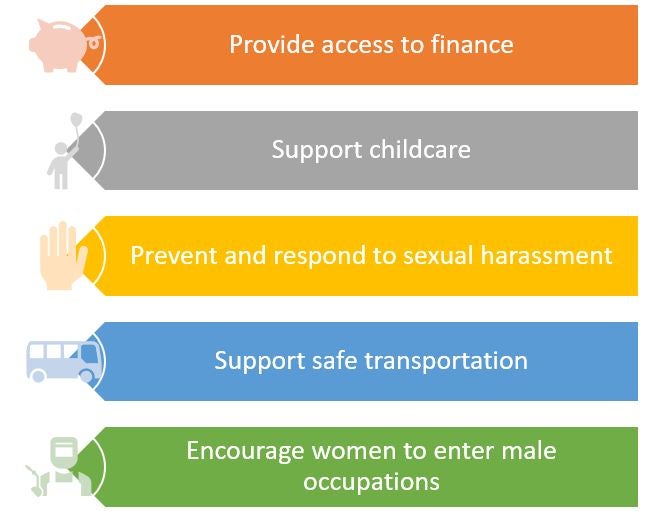 One way to close the gender gap is through skills training such as technical training as well as entrepreneurial or business training programs.
One way to close the gender gap is through skills training such as technical training as well as entrepreneurial or business training programs.
Across the globe, women are less likely to work for pay, and, when they do, they make less. This gender “jobs gap” is driven by many factors, both on the demand and supply side. One way to close the gap is through skills training such as technical training as well as entrepreneurial or business training programs.
However, obstacles related to social norms, childcare, and mobility keep women from accessing and successfully completing such programs. Training programs should not be blind to these constraints in their design. Our Jobs Policy note Adapting Skills Training to Address Constraints to Women’s Participation outlines specific suggestions, based on emerging evidence, on how to re-think training programs to maximize their role in closing the jobs gap.
Here are five ways to help skills training programs boost women’s participation in the workforce.

Accompany training with access to finance
Women typically face more financial constraints than men. This affects their ability to pay for training or related costs, such as transportation. Women also have less access to finance to support expanding their businesses after receiving training. This inhibits participation in skills training itself as well as putting that training to good use.
Offering cash grants conditional on attendance and financial capital to use upon completion of training can help overcome these barriers. And specific features, like secure savings, as well as coupling with mentors, can maximize impacts.
Prevent and address sexual harassment
Skills training programs need mechanisms to prevent, respond to, and report cases of sexual harassment and abuse. Sexual harassment is a leading cause of high job turnover and school and work absenteeism. Addressing it is not only moral but also smart in terms of program success. Among other features, skills training programs should have an anti-sexual harassment policy and code of conduct, a complaints mechanism, training, and awareness-raising for students, instructors, and other program staff.
Support childcare
Childcare is a leading barrier preventing women from participating in skills training. In most (if not all) countries, women bear an unequal responsibility for childcare and household chores. When the youth training program Jovenes en Acción in Colombia offered childcare subsidies and day care at schools, it saw increased participation of women with children under seven. In addition, employment rates and income for women participants improved more than for men in response to childcare provision.
Support safe transportation
Transportation can be a constraint to women’s participation. Not only do women have less income to spend on transportation, but they are more likely to report safety concerns with transportation options than their male peers. Mobility limitations decrease women’s ability to participate in training and income-generating opportunities. In Peru, the youth labor training program ProJoven program doubled the stipend to female trainees with children under the age of five for transportation, meals, and medical insurance, resulting in long-term positive benefits in formal employment for women.
Encourage women to enter traditionally male occupations
Growing evidence shows that women benefit from crossing into traditional male occupations, which pay better. In Uganda, women who moved into male-dominated sectors such as carpentry, electricals, and metal fabrication, made as much as men, and three times more than women who remained in female-dominated sectors.
One way to facilitate this shift is to provide women with information about male-dominated industries (what they pay, availability of relevant training programs). It’s also important to complement skills training with peer groups, networks, and mentorship opportunities. Professional networks are less available for women. When offered as part of business training, peers and mentors can be valuable as business partners or for support or career counseling. This will help increase the likelihood that women find employment in sectors with higher returns.
This blog is based on the Adapting Skills Training to Address Constraints to Women’s Participation Solutions Note, published in May 2020.



Join the Conversation